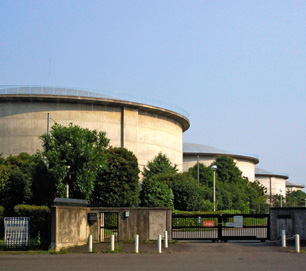Trichloroacetic Acid (TCA)
| EPA Maximum Contaminant Level Goal (MCLG) |
0.02 mg/L |

A water purification plant in Tokorozawa, Japan. TCA may form as a by-product of water chlorination.
Trichloroacetic acid (TCA) is a chemical with a wide range of industrial uses, including the medical industry, metal treatment and as a solvent in plastics.
TCA is one of the five haloacetic acids that make up the EPA regulated “HAA5,” chemicals that may form as a byproduct of water chlorination or chloramination.
Health Effects of Trichloroacetic Acid
Although human studies so far remain insufficient to determine the carcinogenicity of trichloroacetic acid, according to the EPA, there is “suggestive evidence of carcinogenic potential” and research has shown that it can induce tumors in mice.
Human studies have been conducted to test the effects of chlorination byproducts (with TCA being used as a metric) that have shown increased instances of bladder, rectal, and colon cancer, as well as reproductive problems.
Water Treatment for Trichloroacetic Acid
There is no recommended water treatment method for trichloroacetic acid. According to the WHO, it can be reduced during chlorination with coagulation and pH regulation.
Sources: EPA, WHO, Photo: WikiMedia, author: tokoro koko
Site Index
Filtration Systems
- Aeration for Iron & Sulfide
- Backwashing Filters
(whole house & well units)
- Chlorine & Chemical Injectors
- Countertop Water Filters
- Emergency Filters
- Garden Hose Filters
- Reverse Osmosis, Residential
- Reverse Osmosis, Commercial
- Shower Filters
- Specialty Filters
- Ultraviolet Systems
- Undersink Filters
- Water Softeners
- Whole House Filters
Cartridges
Parts
- Replacement Parts
- Faucets
- Filter Media
- Fittings
- Housings
- O-rings
- Pumps
- Pura UV
- R.O. Parts
- R.O. Tanks
- R.O. Booster Pump
- VIQUA UV